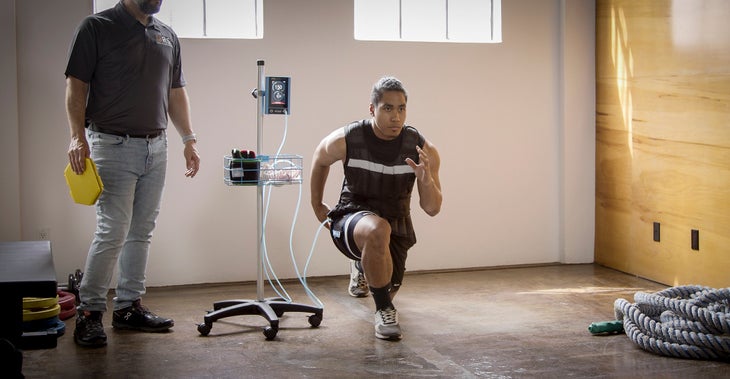Heading out the door? Read this article on the new Outside+ app available now on iOS devices for members! Download the app.
There’s a silver lining to wrecking yourself repeatedly: You learn a lot of cool stuff about the human body. And sometimes, if you’re lucky, you get to play lab rat.
Over the course of my ACL saga—which began in 2007 with my first tear and reconstruction, climaxed in 2012 with my second, then devolved into a cliché in 2019 with a third tear (and yes, another reconstruction)—I’ve had the privilege of experiencing the evolution of medical technology firsthand. I’m happy to report that ACL reconstruction and therapy methods have improved significantly over the years, and Blood Flow Restriction Therapy is just one, very cool example.
During my most recent ACL debacle, I struggled with patellar tendonitis, a common side effect among patients who opt to use a patellar tendon graft in their ACL reconstruction. A typical ACL rehab protocol usually has patients doing a lot of step-ups, step-downs, squats, and lunges as soon as they have the necessary range of motion and can safely bear weight. The idea here is to start building the glutes, hamstrings, and quads back to full strength, a critical step in returning to sport.
On that topic: Understanding how skiing taxes your ACL
But two months into my rehab routine, I couldn’t perform those basic strength exercises without wincing in pain. The still-healing patellar tendon in my right knee was just getting too worked, too inflamed, and too angry. The best way to deal with any kind of tendonitis is rest—stop overtaxing that tendon, and it will gradually heal on its own. But if you want to get back on snow seven months after ACL surgery, there’s no time for rest.
Related: How long is the ACL recover timeline for skiers?
That’s where Blood Flow Restriction Therapy comes in. BFR isn’t a new therapy, and I’m certainly not the first or only patient to have had a compression cuff cinched around my upper thigh like a tourniquet, then have to perform squats until I was almost literally blue in the face while 80 percent of my blood flow was restricted. (I can now confirm that BFR is the very definition of getting “swoll.”) But BFR does seem to be in vogue again, and everyone from elite athletes to regular Joes are turning to it to help them make major muscle gains after injury. Torey Anderson, head physical therapist for the alpine women on the U.S. Ski Team, explains.

What exactly is Blood Flow Restriction Therapy?
Anderson: This type of treatment started being used back in the ’70s but has been gaining popularity again in the last 10 years. We use it in a clinical setting because it’s a really effective tool to allow for low-intensity exercise that simulates a high-intensity environment. If you’re using BFR for an ACL or lower-extremity injury, you’ll typically place the compression cuff high on the thigh. The idea is to control the pressure in the cuff to restrict blood flow, and the protocol is to get an occlusion of about 80 percent of your blood flow. While the cuff is restricting your blood flow, you’ll be asked to perform about 75 reps of an exercise.
What is the point or benefit of BFR?
Anderson: It’s an awesome tool in post-op settings when it’s not appropriate to load healing tissue with heavy resistance, like after an ACL surgery.
When you use the cuff to restrict 80 percent of your blood flow, that creates a tourniquet effect and limits the blood flow to the muscle, which creates a hypoxic (low-oxygen) environment. This allows for the release of growth hormones and creates a limited oxygen supply, which can cause muscle hypertrophy (enlargement). And there’s a correlation between muscle size and strength increases.
When working the same muscles over time in that 80 percent occlusion range, you get a high-intensity effect, so even just squatting with bodyweight can simulate a max-effort exercise.

Who is a good candidate for BFR? Can anyone do it?
Anderson: Anyone can do it. This winter my mom broke her leg and she used BFR in her physical therapy. Anyone who is healthy and doesn’t have heart conditions is a good candidate. But people who have any sort of clotting issue or heart dysfunction should be cleared by their medical provider before using BFR.
Since the objective is hypertrophy, so increasing girth or muscle size, we’ll use BFR in post-ops in those early stages of rehab. We also often use it on athletes who aren’t necessarily in a post-op or initial healing setting, but who are struggling with some kind of compensation left to right, or something’s going on where they can’t tolerate a normal training load. Then you can throw on the BFR cuff and get the same training effect.
Can this therapy only be used on lower extremities?
Anderson: No, you can also use BFR on upper extremities after something like a rotator cuff repair. We do it with a lot of our athletes after all sorts of injuries. As part of our return-to-sport criteria we look at girth and want to get the compromised leg or limb back to a certain percentage of the uncompromised limb, so we use BFR to build muscle symmetry.
On that topic: The importance of muscle symmetry in injury prevention
Is BFR only used in post-op settings, or can it also just be used in a training environment by people who want to get strong quick?
Anderson: I have seen it used in the bodybuilding world, or in the wider strength and conditioning sphere. Some people use it as a training tool more broadly just to get the hypertrophy effects. So if someone is after really big quads, then this could be an effective tool for that.
On the Ski Team, we don’t typically use it for our fully functioning athletes. I travel with a portable unit in the winter just in case we have little injuries that come up or we don’t have access to all of our equipment. But if an athlete is able to push weight and do 100 percent training, then that’s what we want.
More Fitness Inspo for Skiers
How to prevent leg burn from setting in halfway down the run
DIY physical therapy for skiers
Protect your ACL with these hamstring and butt exercises
